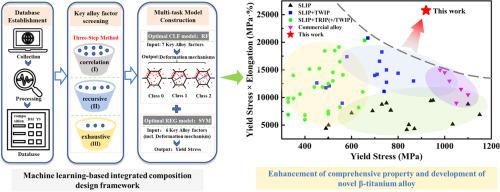β型钛合金的成分-变形机制-性能机器学习模型
IF 12.8
1区 材料科学
Q1 ENGINEERING, MECHANICAL
引用次数: 0
摘要
在结合变形孪晶的同时最大限度地提高固溶硬化是同时提高其强度和延展性的关键。本文章由计算机程序翻译,如有差异,请以英文原文为准。

Composition-deformation mechanism-property machine learning model for strength-ductility improvement of β-type titanium alloys
Maximizing solid-solution hardening while incorporating deformation twinning is crucial for simultaneously enhancing their strength and ductility of β-type titanium alloys. This study proposes an integrated composition design framework (ICDF) that combines a deformation mechanism machine learning model with a yield strength machine learning model. This framework enables precise control of strengthening and deformation mechanism, effectively addressing the strength-ductility trade-off challenge of β-type titanium alloys. First, using the key alloy factor screening method, the key alloy factor-deformation mechanism prediction model and key alloy factor-yield strength prediction model were developed. Then, five kinds of new β-type titanium alloys with excellent comprehensive properties were designed by combining the two models. The new alloy Ti-5Cr-3Mo-1.5Fe exhibited a tensile strength of 1030 MPa, a yield strength of 920 MPa, and an elongation of 28 %. Compared with the commonly used commercial β-type titanium alloy Ti-5Al-5Mo-5V-3Cr (AMS 4983), the strength-ductility product of the new alloy increased by 71.7 %, while the total alloying element content decreased by 47.2 %. The new alloy exhibits intriguing deformation twinning behaviors, including stress-induced {332} 〈113〉 multi-level twinning and {332} 〈113〉 cross-twinning, which, in conjunction with the high solid-solution hardening, results in simultaneous enhancement of strength and ductility. This work provides a novel approach for the rapid design of high performance and low alloying titanium alloys through constructing multi-task models between alloy composition, deformation mechanism and resultant properties.
求助全文
通过发布文献求助,成功后即可免费获取论文全文。
去求助
来源期刊

International Journal of Plasticity
工程技术-材料科学:综合
CiteScore
15.30
自引率
26.50%
发文量
256
审稿时长
46 days
期刊介绍:
International Journal of Plasticity aims to present original research encompassing all facets of plastic deformation, damage, and fracture behavior in both isotropic and anisotropic solids. This includes exploring the thermodynamics of plasticity and fracture, continuum theory, and macroscopic as well as microscopic phenomena.
Topics of interest span the plastic behavior of single crystals and polycrystalline metals, ceramics, rocks, soils, composites, nanocrystalline and microelectronics materials, shape memory alloys, ferroelectric ceramics, thin films, and polymers. Additionally, the journal covers plasticity aspects of failure and fracture mechanics. Contributions involving significant experimental, numerical, or theoretical advancements that enhance the understanding of the plastic behavior of solids are particularly valued. Papers addressing the modeling of finite nonlinear elastic deformation, bearing similarities to the modeling of plastic deformation, are also welcomed.
 求助内容:
求助内容: 应助结果提醒方式:
应助结果提醒方式:


